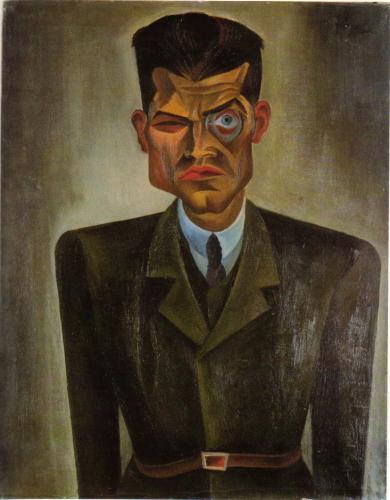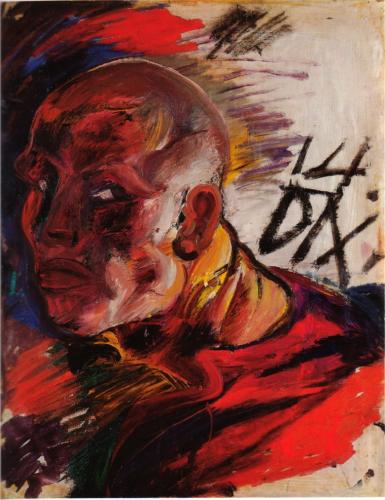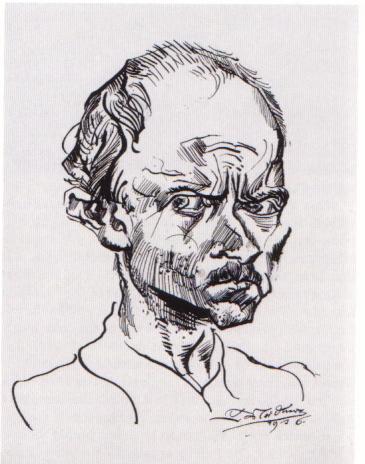-
-
Par MMaxi le 3 December 2006 à 02:22

Metropolis, Georg Grosz ( 1893-1959 )
An Urban Landscape like Metropolis or Explosions almost seems to explode before the viewer's eyes: the city becomes a teeming inferno with leering figures rushing wildly from place to place. Bathed in a red light, Grosz's Berlin is the epitome of the " big city landscape " of second-generacion Expressionism.
Metropolis exemplifies the anarchy of post war Germany.
The scene is Friedrichstrasse, site of the Central Hotel, which Grosz had already depicted in lithographs: beggars, prostitutes, cigar-chomping profiteers, cripples, and convicts intimately glimpsed create a maelstrom of misery and depravity.
This dynamism of the city owes much to the rhytms of Italian Futurism.
-
Par MMaxi le 29 October 2006 à 01:00

Conrad Felixmüller ( 21 May 1897 - 24 March 1977 )
One of the youngst members of the "New Objectivity"
After attending drawing classes at the Dresden Kunstgewerbeschule [School of Applied Arts] for one year, Felixmüller enrolled in the private school of the artist Ferdinand Dorsch in 1912 and, in the same year, the class of Professor Carl Bantzer at the Königliche Akademie [Royal Academy] in Dresden, where he began his training as a painter. When Felixmüller left the Academy in 1915 he worked as an independent artist in Dresden, but also spent much of his time in Berlin, where he painted in Ludwig Meidner's studio. Here he also worked for Herwarth Walden's journal 'Der Sturm' as a graphic designer. Together with the book seller Felix Stiemer the artist founded the art and literature journal 'MENSCHEN' in 1917. He was responsible for the graphic design of this journal. He had exhibitions at Hans Goltz' gallery in Munich and, together with Heckel, Kirchner and Schmidt-Rottluff, at the Galerie Arnold in Dresden. Felixmüller moved to Dresden in 1918. He was a founding and board member of the 'Dresden Sezession' and a member of the 'November Gruppe'. At the same time he worked for various journals (such as 'Die Sichel', Regensburg; 'Rote Erde', Hamburg) and published his own texts, such as his autobiography 'Mein Werden' (Kunstblatt), or his thoughts about 'Künstlerische Gestaltung' [Artistic Design] (Kestnerbuch, Hannover). Felixmüller's early work is strongly influenced by Expressionism which he understood in a socio-critical context and transformed into his own expressive realism. The powerful lines of his woodcuts depict scenes of every-day life. There was a change around 1930, evident in increasingly genre-like, narrative subjects and a calmer pictorial language. 40 works by Felixmüller were included in the 1933 exhibition of 'Degenerate Art' in Dresden. The artist moved to Berlin-Charlottenburg in 1934, hoping that the working environment would be more liberal here. 151 of his works in public collections were confiscated in 1937. When his Berlin domicile was destroyed by a bomb in 1941 Felixmüller sought refuge in Damsdorf in the Mark. He moved to Tautenhain in 1944, but was called-up for military service in the same year. He returned to Tautenhain in 1945 after a brief period as a prisoner-of-war in Russia. He was appointed professor at the Martin-Luther-University in Halle in 1949, teaching drawing and painting in the faculty of education. Felixmüller returned to Berlin after his retirement in 1961. Numerous exhibitions have been dedicated to the artist between the end of the war and the artist's death in both parts of Germany as well as in Paris, Rome, Bologna and Florence.
-
-
-
-
Par MMaxi le 23 October 2006 à 17:35

Original name "Selbstbildnis als Soldat"
Otto Dix (December 2, 1891 - July 25, 1969) was a German expressionist and anti-war painter and a veteran of the First World War. His most famous paintings were a (1928) triptych Metropolis and Trench Warfare (1932).
Otto Dix was born in Untermhaus, Germany, now a part of the city of Gera. In 1910, he entered the Dresden School of Arts and Crafts and supported himself as a portrait painter.
When the First World War erupted, Dix enthusiastically volunteered for the German Army. He was taken to a field artillery regiment in Dresden. In the fall of 1915 he was assigned as a non-commissioned officer of a machine-gun unit in the Western front and took part of the Battle of the Somme. He was seriously wounded several times. In 1917, his unit was transferred to the Eastern front until the end of hostilities with Russia. Back in the western front, he fought in the German Spring offensive. He earned the Iron Cross and reached the rank of vice-sergeant-major.
Dix was profoundly affected by the sights of the war. He would later tell about his recurring nightmare where he was crawling through destroyed houses. He produced a series of drawings and prints that reflected that traumatic period.
In the Weimar Republic Dix studied at the Dresden Art Academy, became a founder of the Dresden Secession, and was a contributor to the Neue Sachlichkeit exhibition in Berlin in 1925. His paintings became his expression of the bleaker side of life, especially war. He used realistic pictures of disfigured soldiers as his model. His 1923 painting The Trench, which depicted dismembered and decomposed bodies of soldiers in a trench after a battle caused such a furor that the Wallraf-Richartz Museum hid the painting behind a curtain. In 1925 the then-mayor of Cologne, Konrad Adenauer, cancelled the purchase of the painting and forced the director of the museum to resign.
Like the work of his friend and fellow veteran George Grosz, Dix's material was extremely critical of contemporary German society and often dwelled on the act of Lustmord, or sexual murder. Dix's postwar depictions of soldiers and veterans very clearly illustrates their invisibility within contemporary German society, a concept also developed in Erich Maria Remarque's All Quiet on the Western Front.
When the Nazis came to power in Germany, they regarded Dix as a degenerate artist and had him sacked from his post as an art teacher at the Dresden Academy. He later moved to Lake Constance. Dix's paintings The Trench and War cripples were exhibited in the Nazi exhibition of degenerate art, Entartete Kunst. They were later burned.
Dix was forced to join the Nazi-controlled Imperial chamber of Fine Arts in order to be able to work as an artist at all and had to promise to paint only landscapes. He still painted an occasional allegorical painting that criticized Nazi ideals. In 1939 he was arrested on a trumped-up charge of being involved in a plot against Hitler but was later released.
During World War II Dix was conscripted into the Volkssturm. He was captured by French troops at the end of the war and released in February 1946.
Dix eventually returned to Dresden. After the war most of his paintings were religious allegories or depictions of post-war suffering.
Otto Dix died in Singen, Germany, in 1969. Follow this section's article RSS flux
Follow this section's article RSS flux
MMaxi Madeiraman






